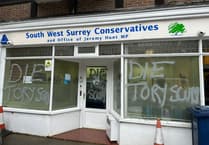ONE never knows where a feature on the Peeps page will lead.
Our story, in March, featuring the railway arch on the border of Pirbright and Brookwood, was followed by one in April about how the structure had a starring role in the 1960 comedy film Two-Way Stretch. And now, there’s more.
Dave Middleton wrote to say he used to lead a walk, for Guildford Walkfest, that visited the arch because of its use in the movie.
On one occasion, a man who came on the walk told Dave he had lived in Pirbright when Two-Way Stretch was being made and he witnessed another scene being filmed outside the village’s White Hart pub. He said his mum had taken him to watch the action.
In that scene, the landlady poured a jug of water from an upstairs window over the police officer in charge of guarding some diamonds. The officer went to fire his flare pistol – but when he pulled the trigger, only bubbles emerged.
Dave said that the man on the walk remembered some foam landing on him – and the real landlady of the pub appeared in the scene.
Dave pointed out that from the Pirbright side of the railway arch, a footpath leads through woods to School Lane, and on the way you can see where a lot of digging had taken place.
He was told by an elderly resident of Pirbright that his father had said the digging dated to the First World War, when soldiers had come from Aldershot to practise building trenches.
I can add to that. When heading west from Pirbright along the B3012 Gape Mouth Road, where it does a sharp bend to become Guildford Road, turn off along Tunnel Hill Road and you will see something interesting in the woods on the left.
It appears to be a mock First World War trench system. Although nature is slowly reclaiming what had once been dug out, it is possible to walk through existing sections of trenches that link together, just as the real ones would have done on the Western Front battlefields.
Before the First World War, the heathland around Pirbright and Tunnel Hill, and towards Deepcut, Camberley and Aldershot, was being used extensively by the army for training purposes.
When I replied to Dave’s email, I mentioned the trench system I know about.
He responded: “When I was at school, myself and friends used to ride our bikes to that area and have adventures.
“Back then, the late 1950s and early 1960s, the army did a lot of training there, and we often found new trenches and foxholes.
“I remember hiding in a camouflaged foxhole, and someone rode a horse over the top and the hole started to cave in.
“We often found ammunition boxes, containing things like detonators, just left lying about.
“We had secret camps in the pillboxes on the road junction. They frequently showed signs of having been used by rough sleepers.
“There were lots of what were known as tramps around in those days. They were people who found themselves homeless or having other related problems following the Second World War.
“Sometimes they knocked on our front door in Lower Knaphill and asked my mum for a drink of water, obviously hoping for perhaps more.
“And sometimes they would peddle copies of Old Moore’s Almanac.
“On one occasion, one of the tramps wrote some marks on our gate post. I think it was a message to others in the same boat.”
David is correct about the marks. Tramps and vagrants did chalk secret signs on gates and walls of houses to inform each other what the occupants were like and whether they were friendly or likely to call the police.
IF you have memories or old pictures relating to the Woking area and its people which you would like to contribute to this page, call David Rose on 01483 838960, or write to the News & Mail.




